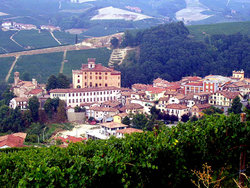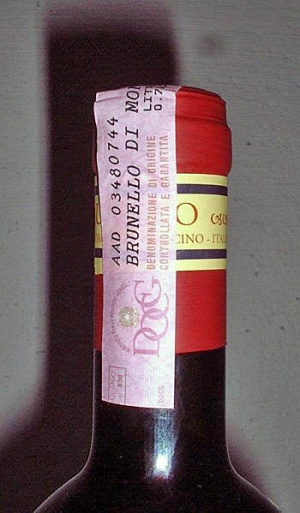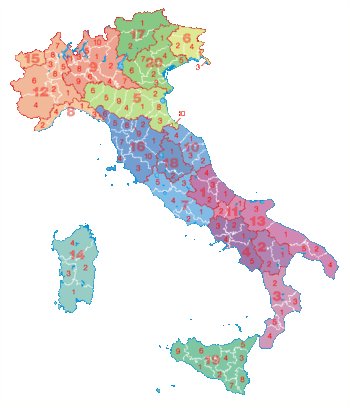Difference between revisions of "Italian wine"
m |
m |
||
| Line 2: | Line 2: | ||
[[Image:Uva, Olivetrees, Oaks, Vineyards.jpg|thumb|right|250px|A classical Italian vineyard scene, with vines growing together with [[olive tree]]s.]] | [[Image:Uva, Olivetrees, Oaks, Vineyards.jpg|thumb|right|250px|A classical Italian vineyard scene, with vines growing together with [[olive tree]]s.]] | ||
[[Image:Barolo veduta.JPG|thumb|right|250px|Vineyards around the town of [[Barolo (CN)|Barolo]].]] | [[Image:Barolo veduta.JPG|thumb|right|250px|Vineyards around the town of [[Barolo (CN)|Barolo]].]] | ||
| + | |||
'''Italian wine''' is [[wine]] produced in [[Italy]], a [[country]] which is home to some of the oldest wine-producing regions in the world. [[Etruscans]] and [[Greeks|Greek]] settlers produced wine in the country long before the [[Ancient Rome|Romans]] started developing their own [[vineyard]]s in the second century BC. Roman [[Viticulture|grape-growing]] and [[winemaking]] was prolific and well-organized, pioneering large-scale production and storage techniques like [[barrel]][[cooper (profession)|-making]] and [[bottling]]. Two thousand years later, Italy remains one of the world's foremost producers, responsible for approximately one-fifth of world wine production in 2005. | '''Italian wine''' is [[wine]] produced in [[Italy]], a [[country]] which is home to some of the oldest wine-producing regions in the world. [[Etruscans]] and [[Greeks|Greek]] settlers produced wine in the country long before the [[Ancient Rome|Romans]] started developing their own [[vineyard]]s in the second century BC. Roman [[Viticulture|grape-growing]] and [[winemaking]] was prolific and well-organized, pioneering large-scale production and storage techniques like [[barrel]][[cooper (profession)|-making]] and [[bottling]]. Two thousand years later, Italy remains one of the world's foremost producers, responsible for approximately one-fifth of world wine production in 2005. | ||
Latest revision as of 14:51, 3 October 2009


Italian wine is wine produced in Italy, a country which is home to some of the oldest wine-producing regions in the world. Etruscans and Greek settlers produced wine in the country long before the Romans started developing their own vineyards in the second century BC. Roman grape-growing and winemaking was prolific and well-organized, pioneering large-scale production and storage techniques like barrel-making and bottling. Two thousand years later, Italy remains one of the world's foremost producers, responsible for approximately one-fifth of world wine production in 2005.
Wine is a popular drink in Italy. Grapes are grown in almost every part of Italy, with more than 1 million vineyards under cultivation. In some places the vines are trained along low supports. In others they climb as slender saplings.
Most wine-making in Italy is done in modern wineries. However, villagers who make wine for their own use sometimes still tread the grapes with their bare feet, until the juice is squeezed out. They believe this ancient method still makes the best wine.
History
Although wines had been elaborated from the wild Vitis vinifera grape for millennia, it wasn't until the Greek colonization that wine-making flourished. Viticulture was introduced into Sicily and southern Italy by the Mycenaean Greeks, and was well established when the extensive Greek colonization transpired around 800 BC. It was during the Roman defeat of the Carthaginians (acknowledged masters of wine-making) in the second century BC that Italian wine production began to further flourish. Large-scale, slave-run plantations sprang up in many coastal areas and spread to such an extent that, in AD92, emperor Domitian was forced to destroy a great number of vinyards in order to free up fertile land for food production.
During this time, viticulture outside of Italy was prohibited under Roman law. Exports to the provinces were reciprocated in exchange for more slaves, especially from Gaul where trade was intense, according to Pliny, due to the inhabitants being besotted with Italian wine, drinking it unmixed and without restraint. Roman wines contained more alcohol and were generally more powerful than modern fine wines. It was customary to mix wine with a good proportion of water which may otherwise have been unpalatable, making wine drinking a fundamental part of early Italian life.
As the laws on provincial viticulture were relaxed, vast vineyards began to flourish in the rest of Europe, especially Gaul (present day France) and Hispania. This coincided with the cultivation of new vines, like biturica (ancestor of the Cabernets). These vineyards became hugely successful, to the point that Italy ultimately became an import centre for provincial wines.
Depending on the vintage, modern Italy is the world's largest or second largest wine producer. In 2005, production was about 20% of the global total, second only to France, which produced 22%. In the same year, Italy's share in dollar value of table wine imports into the U.S. was 32%, Australia's was 24%, and France's was 20%. Along with Australia, Italy's market share has rapidly increased in recent years.
Italian appellation system
Italy's classification system is a modern one that reflects current realities. It has four classes of wine, with two falling under the EU category Quality Wine Produced in a Specific Region (QWPSR) and two falling under the category of 'table wine'. The four classes are:
Table Wine:
- Vino da Tavola (VDT) - Denotes wine from Italy. NOTE: this is not always synonymous with other countries' legal definitions of 'table wine'. The appellation indicates either an inferior quaffing wine, or one that does not follow current wine law. Some quality wines do carry this appellation.
- Indicazione Geografica Tipica (IGT) - Denotes wine from a more specific region within Italy. This appellation was created for the "new" wines of Italy, those that had broken the strict, old wine laws but were wines of great quality. Before the IGT was created, quality "Super Tuscan" wines such as Tignanello and Sassicaia were labeled Vino da Tavola.
QWPSR:
- Denominazione di Origine Controllata (DOC)
- Denominazione di Origine Controllata e Garantita (DOCG)
Both DOC and DOCG wines refer to zones which are more specific than an IGT, and the permitted grapes are also more specifically defined. The main difference between a DOC and a DOCG is that the latter must pass a blind taste test for quality in addition to conforming to the strict legal requirements to be designated as a wine from the area in question. Presently, there are 120 IGT zones. In February 2006 there were 311 DOC plus 32 DOCG appellations, according to the PDF document V.Q.P.R.D. Vini (DOCG – DOC): Elenco e Riferimenti Normativi al 07.02.2006, published by the Italian Ministry of Agriculture.
Geographical characteristics
Important wine-relevant geographic characteristics of Italy include:
- The extensive latitudinal range of the country permits wine growing from the Alps in the north to almost within sight of Africa in the south;
- The fact that Italy is a peninsula with a long shoreline, contributing moderating climate to coastal wine regions; and
- The extensive mountains and foothills providing many altitudes for grape growing and a variety of climate and soil conditions.
Italian wine regions
Italy's 20 wine regions correspond to the 20 political regions. Understanding of Italian wine becomes clearer with an understanding of the differences between each region; their cuisines reflect their indigenous wines, and vice-versa. The 36 docg wines are located in 13 different regions but most of them are concentrated in Piedmont and Tuscany. Among these are appellations appreciated and sought by wine lovers around the world: Barolo, Barbaresco, Brunello and Chianti Classico. Despite its high quality Amarone is not classified as a Docg.
The regions are, roughly from Northwest to Southeast:
- Aosta Valley (Valle D'Aosta)
- Piedmont (Piemonte)
- Liguria
- Lombardy (Lombardia)
- Trentino-Alto Adige/Südtirol
- Friuli-Venezia Giulia
- Veneto
- Emilia-Romagna
- Tuscany (Toscana)
- Marche (Le Marche)
- Umbria
- Lazio
- Abruzzo
- Molise
- Campania
- Basilicata
- Apulia (Puglia)
- Calabria
- Sicily (Sicilia)
- Sardinia (Sardegna)
Key Italian wine varietals
Italy's Ministry of Agriculture and Forestry (MIRAF), has documented over 350 grapes and granted them "authorized" status. There are more than 500 other documented varietals in circulation as well. The following is a list of the most common and important of Italy's varietals.
Rosso (Red)
- Sangiovese - Italy's claim to fame, the pride of Tuscany. Its wines are full of cherry fruit, earth, and cedar. It produces Chianti Classico, Rosso di Montalcino, Brunello di Montalcino, Rosso di Montepulciano, Montefalco Rosso, and many others.
- Nebbiolo - The most noble of Italy's varietals. The name (meaning "little fog") refers to the autumn fog that blankets most of Piedmont where it is grown, a condition the grape seems to enjoy. It is a somewhat difficult varietal to master, but produces the most renowned Barolo and Barbaresco, made in province of Cuneo, along with the lesser-known Sforzato, Inferno and Sassella made in Valtellina, Ghemme and Gattinara, made in Vercelli's province. The wines are known for their elegance and bouquet of wild mushroom, truffle, roses, and tar.
- Montepulciano - The grape of this name is not to be confused with the Tuscan town of Montepulciano; it is most widely planted on the opposite coast in Abruzzo. Its wines develop silky plum-like fruit, friendly acidity, and light tannin.
- Barbera - The most widely grown red wine grape of Piedmont and Southern Lombardy, most famously around the towns of Asti and Alba, and Pavia. The wines of Barbera were once simply "what you drank while waiting for the Barolo to be ready." With a new generation of wine makers, this is no longer the case. The wines are now meticulously vinified, aged Barbera gets the name "Barbera Superiore" (Superior Barbera), sometimes aged in French barrique becoming "Barbera Barricato", and intended for the international market. The wine has bright cherry fruit, a very dark color, and a food-friendly acidity.
- Corvina - Along with the varietals rondinella and molinara, this is the principal grape which makes the famous wines of the Veneto: Valpolicella and Amarone. Valpolicella wine has dark cherry fruit and spice. After the grapes undergo passito (a drying process), the Amarone they yield is elegant, dark, and full of raisinated fruits. Some Amarones can age for 40+ years.
- Nero d'Avola - Nearly unheard of in the international market until recent years, this native varietal of Sicily is gaining attention for its robust, inky wines, and has therefore been nicknamed "the Barolo of the South".
- Dolcetto - A grape that grows alongside barbera and nebbiolo in Piedmont, its name means "little sweet one"", referring not to the taste of the wine, but the ease in which it grows and makes great wines, suitable for everyday drinking. Flavors of concord grape, wild blackberries and herbs permeate the wine.
- Negroamaro - The name literally means "black and bitter". A widely planted grape with its concentration in the region of Puglia, it is the backbone of the acclaimed Salice Salentino: spicy, toasty, and full of dark red fruits.
- Aglianico - Considered the "noble varietal of the south," it is primarily grown in Campania and Basilicata. The name is derived from Hellenic, so it is considered a Greek transplant. Thick skinned and spicy, the wines are often both rustic and powerful.
- Sagrantino - A native to Umbria, it is only planted on 250 hectares, but the wines are world-renowned. Inky purple, with rustic brooding fruit and heavy tannins, these wines can age for many years.
- Malvasia Nera - Red Malvasia varietal from Piedmont. A sweet and perfumed wine, sometimes elaborated in the passito style.
Other major red varieties are Ciliegolo, Gaglioppo, Lagrein, Lambrusco, Monica, Nerello Mascalese, Pignolo, Primitivo, Refosco, Schiava, Schiopettino, Teroldego, and Uva di Troia.
"International" varietals such as Merlot, Cabernet Sauvignon, Syrah, and Cabernet Franc are also widely grown.
Bianco (White)
- Trebbiano - Behind cataratto (which is made for industrial jug wine), this is the most widely planted white varietal in Italy. It is grown throughout the country, with a special focus on the wines from Abruzzo. Mostly, they are pale, easy drinking wines, but trebbiano from producers such as Valentini have been known to age for 15+ years. It is known as Ugni Blanc in France.
- Moscato - Grown mainly in Piedmont, it is mainly used in the slightly-sparkling (frizzante), semi-sweet Moscato d'Asti. Not to be confused with moscato giallo and moscato rosa, two Germanic varietals that are grown in Trentino Alto-Adige.
- Nuragus - An ancient Phoenician varietal found in southern Sardegna. Light and tart wines that are drunk as an apertif in their homeland.
- Pinot Grigio - A hugely successful commercial grape (known as Pinot Gris in France), its wines are characterized by crispness and cleanness. As a hugely mass-produced wine, it is usually delicate and mild, but in a good producers' hands, the wine can grow more full-bodied and complex. The main problem with the grape is that to satisfy the commercial demand, the grapes are harvested too early every year, leading to wines without character.
- Tocai Friulano - A varietal distantly related to Sauvignon Blanc, it yields the top wine of Friuli, full of peachiness and minerality. Currently, there is a bit of controversy regarding the name, as the EC has demanded it changed to avoid confusion with the Tokay dessert wine from Hungary.
- Ribolla Gialla - A Slovenian grape that now makes its home in Friuli, these wines are decidedly old-world, with aromas of pineapple and mustiness.
- Arneis - A crisp and floral varietal from Piedmont, which has been grown there since the 15th century.
- Malvasia Bianca - Another white varietal that peeks up in all corners of Italy with a wide variety of clones and mutations. Can range from easy quaffers to funky, musty whites.
- Pigato - A heavily acidic varietal from Liguria, the wines are vinified to pair with a cuisine rich in seafood.
- Fiano (wine) - Grown on the southwest coast of Italy, the wines from this grape can be described as dewy and herbal, often with notes of pinenut and pesto.
- Garganega - The main grape varietal for wines labeled Soave, this is a crisp, dry white wine from the Veneto wine region of Italy. It's a very popular wine that hails from northeast Italy around the city of Verona. Currently, there are over 3,500 distinct producers of Soave.
Other important whites include Carricante, Catarratto, Coda de Volpe, Cortese, Falaghina, Grillo, Inzolia, Picolit, Traminer, Verdicchio, Verduzzo, Vermentino and Vernaccia.
As far as non-native varietals, the Italians plant chardonnay, gewürztraminer (sometimes called traminer aromatico), riesling, petite arvine, and many others.
Super Tuscans
The term "Super Tuscan" describes any Tuscan red wine that does not adhere to traditional blending laws for the region. For example, Chianti Classico wines are made from a blend of grapes with Sangiovese as the dominant varietal in the blend. Super Tuscans often use other grapes, especially cabernet sauvignon, making them ineligible for DOC(G) classification under the traditional rules.
In 1968 Azienda Agricola San Felice produced the first ever "Super Tuscan" called Vigorello, and in the 1970s Piero Antinori, whose family had been making wine for more than 600 years, also decided to make a richer wine by eliminating the white grapes from the Chianti blend, and instead adding Bordeaux varietals (namely, cabernet sauvignon and merlot). He was inspired by a little-known (at the time) cabernet sauvignon made by relatives called Sassicaia, which openly flouted the rules set down for traditional wines in Tuscany. The result was one of the first Super Tuscans, which he named Tignanello, after the vineyard where the grapes were grown. Other winemakers started experimenting with Super Tuscan blends of their own shortly thereafter.
Because these wines did not conform to strict DOC(G) classifications, they were initially labeled as vino da tavola, meaning "table wine," a term ordinarily reserved for lower quality wines. The creation of the Indicazione Geografica Tipica category (technically indicating a level of quality between vino da tavola and DOCG) helped bring Super Tuscans "back into the fold" from a regulatory standpoint.
External links
- ItalianMade: Italian Wines, from the Italian Trade Commission
- Vino Veritas Italian wines tasting notes Template:It
- Article on the wines of Tuscany

